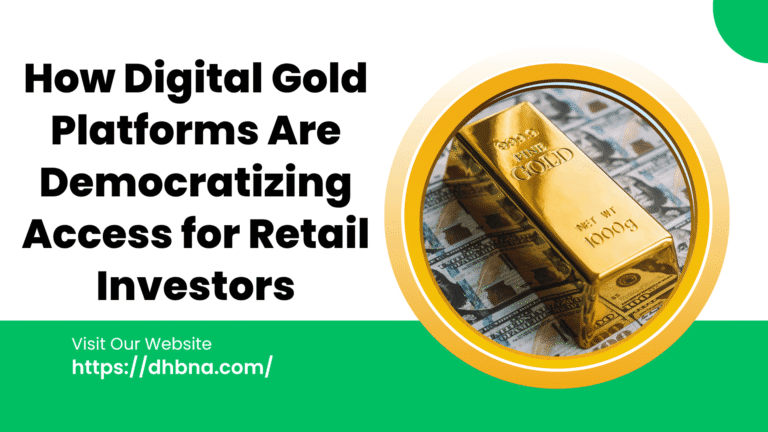Introduction: Digital Gold Platforms and Retail Access
How digital gold platforms are democratizing access for retail investors is not just a headline—it represents a paradigm shift in how everyday individuals invest in gold. Traditional gold ownership required handling physical bars or coins, secure storage, and high minimum purchase amounts. Digital gold platforms have upended this model by offering fractional ownership, instant trading, and institutional-level security. In this article, we explore the rise of digital gold platforms, examine the ways they are democratizing access for retail investors, and highlight best practices for those looking to diversify their portfolios with gold.
Understanding Digital Gold Platforms
What Are Digital Gold Platforms?
Digital gold platforms are online services that allow users to buy, sell, and store gold in a digital format. Instead of taking physical delivery, investors hold ownership titles to allocated gold stored in secure vaults. These platforms leverage technology to streamline transactions, provide real-time pricing, and enable fractional investments with as little as one dollar worth of gold.
The Evolution of Gold Investing
Before digital disruption, gold investing involved:
- Purchasing physical gold through dealers or banks.
- Dealing with premium markups, insurance costs, and storage fees.
- Tracking market prices but executing trades during limited hours.
Digital gold platforms debuted in the mid-2010s to remove these frictions. By integrating cutting-edge fintech solutions, they offer a user-friendly alternative to traditional bullion holdings.
How Digital Gold Platforms Are Democratizing Access for Retail Investors
Reducing Minimum Investment Thresholds
One of the most significant ways digital gold platforms are democratizing access for retail investors is by lowering entry barriers. Platforms like Glint, Vaulted, and Goldmoney allow users to purchase fractions of a gram or ounce, with minimum buys starting at $1–$5. This inclusivity opens gold investing to a broader demographic, including young professionals and low-income savers.
Offering Instant Liquidity Around the Clock
Traditional gold markets close at specific times, but digital gold platforms operate 24/7. Investors can buy or sell at real-time prices any time of day, providing liquidity that aligns with modern consumer expectations. Mobile apps with one-click trading make it simple to react to market events and manage positions on the go.
Simplifying Secure Storage and Insurance
The responsibility of storing and insuring physical gold often deterred smaller investors. Digital gold platforms outsource these challenges by housing allocated gold in insured, audited vaults—often at vaults operated by Brinks, Loomis, or other reputable custodians. This institutional-grade security is offered at a fraction of the cost previously borne by individual investors.
Transparent Pricing and Low Fees
Opaque pricing and high markups plagued traditional gold purchases. Digital platforms provide transparent, real-time pricing with small spreads—often under 1%. Some platforms charge subscription fees instead of transaction commissions, further reducing the cost of entry. This transparency fosters trust and encourages frequent, small-scale investing.
Integration with Digital Wallets and Payment Systems
By integrating with existing digital wallets, payment apps, and bank accounts, digital gold platforms ensure a seamless user experience. Investors can transfer funds from PayPal, credit cards, or direct bank transfers, then purchase gold instantly. Peer-to-peer transfers of gold titles between users are also possible on certain networks, creating a digital economy around gold assets.
Educational Resources and Automated Investing
Retail investors often lack the financial literacy to navigate commodities markets. Many digital gold platforms include built-in educational content—webinars, tutorials, and market analysis—to guide new users. Some offer automated investment plans, allowing customers to dollar-cost average their gold purchases with recurring buys, further democratizing access by removing the need for active trading knowledge.
Key Features of Leading Digital Gold Platforms
Fractional Ownership and Micro-Investments
- Fractional Units: Invest in as little as 0.001 grams of gold.
- Micro-Savings Plans: Round-up features allow spare change from everyday purchases to accumulate in gold.
Real-Time Trading and Price Alerts
- 3-second Price Updates: Instantaneous quotes linked to LBMA spot prices.
- Custom Alerts: Email or push notifications for target price triggers.
Institutional-Grade Security and Audits
- Allocated and Segregated Storage: Each user’s gold is individually allocated and fully insured.
- Third-Party Audits: Regular attestations by independent firms ensure transparency and trust.
Regulatory Compliance and Consumer Protection
Many platforms operate under financial authority oversight, ensuring user funds are safeguarded and operations comply with anti-money-laundering (AML) and know-your-customer (KYC) regulations.
Benefits for Retail Investors
Accessibility and Inclusion
By eliminating high minimums and complexity, digital gold platforms empower everyday investors to include gold in their portfolios—a privilege once reserved for high-net-worth individuals and institutions.
Diversification and Risk Management
Gold has long been a hedge against inflation and market volatility. With easy access via digital platforms, retail investors can quickly adjust their gold exposure in response to macroeconomic changes, enhancing portfolio stability.
Cost Efficiency and Affordability
Competitive fee structures and low trading costs mean that small-scale investors retain more of their returns. Dollar-cost averaging becomes practical, further reducing the impact of short-term market swings.
Financial Education and Engagement
Gamified interfaces, educational content, and community forums on digital gold platforms foster greater financial literacy, helping retail investors make informed decisions beyond gold alone.
Challenges and Considerations
Counterparty Risk and Platform Stability
Although vaults are insured, users remain exposed to the platform’s operational risk. Investors should choose platforms with strong capitalization, proven track records, and transparent financials.
Regulatory Variances Across Jurisdictions
Global regulation of digital gold platforms varies. Retail investors must ensure their chosen service adheres to local laws and offers adequate consumer protections.
Redemption and Physical Delivery Constraints
While digital ownership is convenient, some platforms impose minimum thresholds for physical delivery requests. Users planning to take physical delivery must review these terms carefully.
Cybersecurity and Data Privacy
As with any fintech service, digital gold platforms face cybersecurity threats. Prioritize providers with robust encryption, multi-factor authentication, and regular penetration testing.
Future Outlook: The Next Phase of Gold Digitization
Tokenization and Blockchain Integration
The incorporation of blockchain technology promises further democratization by enabling peer-to-peer gold transfers, global interoperability, and immutable audit trails. Projects tokenizing gold on public blockchains aim to create a truly decentralized gold market.
Integration with Decentralized Finance (DeFi)
Gold-backed tokens could serve as collateral in DeFi protocols, unlocking yield-generating opportunities for retail investors. This convergence of gold and DeFi could expand access to margin lending, liquidity pools, and derivatives previously unavailable to non-professional investors.
Expanding Product Offerings
Digital platforms are diversifying into digital silver, platinum, and even carbon credits—creating a suite of tokenized commodities. Retail investors will benefit from consolidated access points and unified portfolio management.
Enhanced Regulatory Frameworks
As digital gold adoption accelerates, regulators will likely introduce standardized guidelines to protect consumers and ensure market integrity. This maturing oversight will bolster investor confidence and spur further platform growth.
Conclusion: Embracing the Democratization of Gold Investing
How digital gold platforms are democratizing access for retail investors marks a turning point in wealth-building and financial inclusion. By lowering barriers, offering real-time trading, and providing institutional security, these platforms allow anyone to participate in gold markets. As tokenization and DeFi integration gather pace, the potential for retail investors to leverage gold in innovative ways will only grow.
Action Steps for Retail Investors:
- Research Platforms: Evaluate fees, storage arrangements, and regulatory compliance.
- Start Small: Utilize fractional ownership and automated plans to build your stake over time.
- Stay Informed: Leverage educational materials and set price alerts to make timely decisions.
- Diversify: Combine gold with other assets—stocks, bonds, or tokenized commodities—for balanced portfolio growth.
Embrace the new era of gold investing and harness the power of digital gold platforms to secure your financial future.



